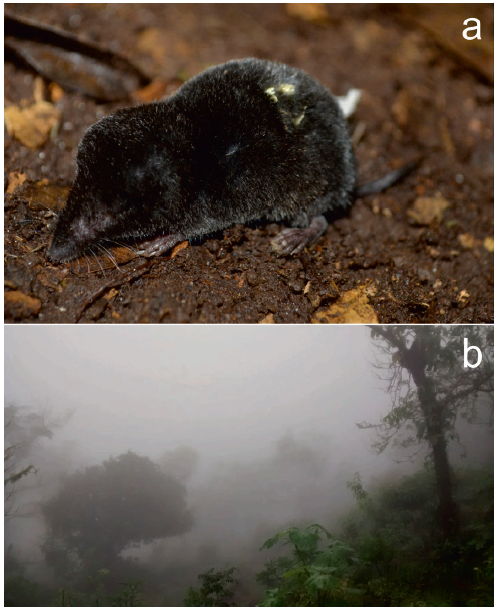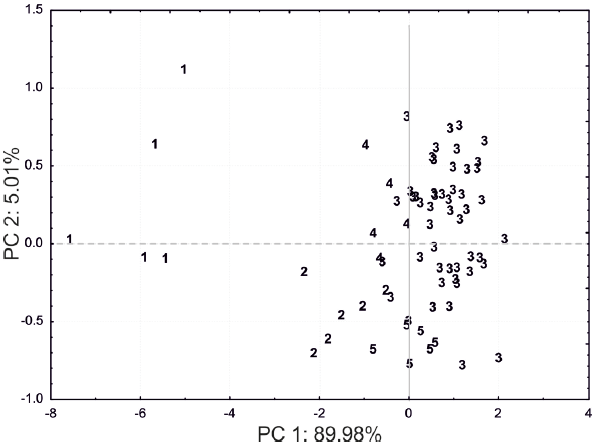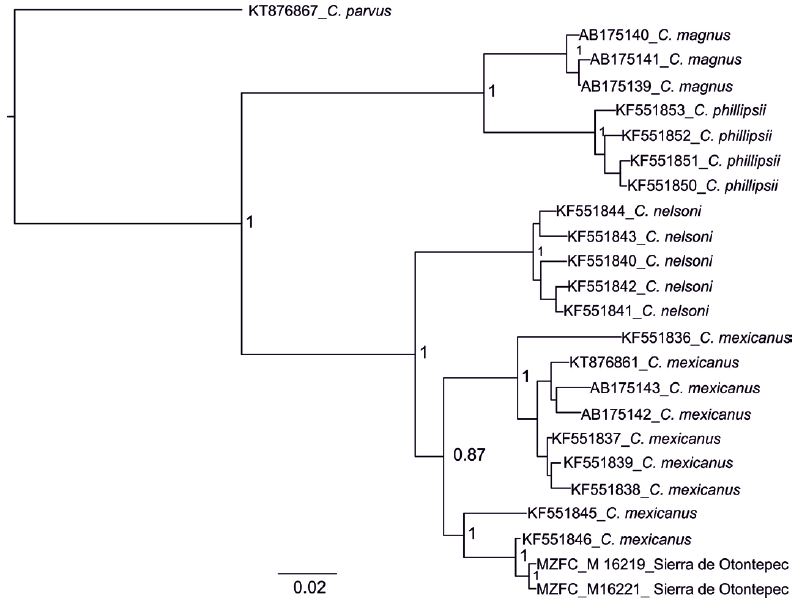Introduction
Knowledge of the diversity and geographical distribution of mammals in tropical and subtropical regions remains incomplete (Ceballos and Ehrlich 2009). This is due, in large part, to the fact that many species inhabit remote areas with limited accessibility. This is particularly problematic when collecting small and secretive species that are difficult to find. Small-eared shrews (Eulipotyphla, Soricidae) of the genus Cryptotis Pomel, 1848 comprise a group of small- to medium sized species occurring from southeastern Canada to northern South America (Choate 1970). With about 44 species (Zeballos et al. 2013), Cryptotis is one of the most diverse genera of small mammals in the Americas. Discovery and description of new species, new distributional records, and range extensions for this genus are not unusual even today (Woodman 2010; Guevara et al. 2014; Guevara and Sánchez-Cordero 2018a).
Recently, while working on mammal inventories, our field team discovered a handful of specimens of small-eared shrews in the cloud forest of the Sierra de Otontepec (Figure 1), an isolated mountain in Veracruz, Mexico, where biological inventories and research has been scarce (Hall and Dalquest 1963; Secretaría de Desarrollo Social y Medio Ambiente, SEDESMA, 2007). Here we provide morphological, molecular, and ecological information on these specimens that could be used to better understand the evolutionary and biogeographic history of the genus. Because the fauna in the Sierra de Otontepec is poorly known and most of the natural vegetation in the region has already been altered by human activity, we emphasize the biological relevance of this discovery.
Materials and Methods
Study area. The Sierra de Otontepec (also known as Sierra de Tantima) lies on the eastern slope of the Sierra Madre Oriental, Veracruz, Mexico (Figure 1). It is a small, isolated volcanic mountain in the Gulf Coastal Plain that reaches an elevation of nearly 1,300 m, and with an extended range of nearly 20 km (SEDESMA 2007). The summit vegetation begins at 900 masl and consists largely of cloud forest, making it one of the northernmost stands of cloud forest in the Neotropics.
Fieldwork. The Mexican Ministry of the Environment (SEMARNAT) authorized the capture of mammals under the scientific collector permit SGPA/DGVS/12142/16 issued to LLP. Fieldwork was carried out for 15 consecutive days in August 2016. We used 10 pitfall and 80 Sherman traps, which were placed next to rocks around the bases of the trees and next to fallen trunks. We conducted trapping at two locations covered by dense cloud forest (Site 1: 21.26855278 N, -97.84444 W, 1,080 m; Site 2: 21.24715 N, -97.895 W, 1,020 m), which have not been intensively surveyed for small mammals. We followed standard recommendations on specimen capture, sacrifice and preparation (Sikes et al. 2016). We measured (mm) and weighed (g) voucher specimens in the field and deposited skins, skeletons, and tissues samples at the Mammal Collection of the Museo de Zoología “Alfonso L. Herrera”, Facultad de Ciencias, Universidad Nacional Autónoma de México (MZFC-M, Mexico City; Appendix 1).
Taxonomic identification. We focused morphological and molecular analyses on the comparison with members of C. mexicanus species group (C. magnus, C. nelsoni, C. mexicanus, and C. phillipsii) because of their greater similarity in pelage coloration, body size, size of forefeet and claws to the specimens from Sierra de Otontepec. We recorded the following cranial measurements for quantitative comparisons: condylobasal length (CBL), cranial breadth (CB), breadth of the palate across the second molars (M2B), and breadth across the first unicuspids (U1B). All measurements were taken with a Mitutoyo electronic caliper at 0.01 mm precision under a stereomicroscope (Appendix 1). We performed a principal component analysis (PCA) on the matrix correlation of four cranial variables to describe and evaluate the degree of differentiation among the species of the Cryptotis mexicanus group.
We also conducted a Bayesian Inference to determine the genetic affinity of the specimens from Sierra de Otontepec within the Cryptotis mexicanus group. We amplified the mitochondrial gene cytochrome b (cytb = 1,140 bp) by a polymerase chain reaction (PCR) using the pair of primers MVZ05 and H15915. The PCR profile included 3 min of initial denaturation at 95° C, followed by 35 cycles of 30 s of denaturation at 95° C, 1 min of annealing at 49° C, and 2 min for extension at 72° C. Finally, we included a step of 5 min of final extension at 72° C. We used the Montage PCR purification kit from Millipore, and the ABI PRISM BigDye Terminator cycle sequencing kit with AmpliTaq DNA polymerase for sequencing the PCR products in an ABI 3730XL sequencer (Applied Biosystems, Seoul, Korea). Both, cleaning of PCR products and sequencing reaction was performed in Macrogen Inc. (Seoul, Korea) following the standard protocols. The sequences generated were deposited in the GenBank database (Accession #’s MK286564-MK286565). We included 21 cytb sequences from the C. mexicanus species group and one sequence of C. parvus (used as outgroup) housed in the GenBank database (see accession numbers on Figure 4, downloaded on 07 November, 2018). Using PartitionFinder 2 (Lanfear et al. 2017), we selected the best scheme of partition and evolution model (cytb [1] = SYM+Γ; cytb [2] = F81+I; cytb [3] = GTR+I). We then incorporated this partition and evolution model in a phylogenetic analysis using Bayesian inference (MrBayes 3.2.3; Ronquist et al. 2012). We used three hot and one cold chains in two independent runs of 10 million generations, sampling data every 1,000 iterations. The final topology was obtained using a majority tree consensus and considering a burn-in of 25 %. We checked the convergence of our results and a good sampling (ESS > 200) in Tracer 1.6.

Figure 2 A) Specimen of a small-eared shrew collected in Sierra de Otontepec, Mexico. B) Typical cloud forest habitat of the Sierra de Otontepec, where small-eared shrews were collected.

Figure 3 Plot of the first 2 principal components from a principal component analysis (PCA) of four cranial measurements from C. magnus (1), C. nelsoni (2), C. mexicanus (3), C. phillipsii (4), and the specimens from Sierra de Otontepec (5).
Results
We obtained a total of six shrew specimens in the cloud forests from the Sierra de Otontepec; four were collected with pitfall traps and two with Sherman traps. The sample included three adult males (MZFC-M 16221, 16223-16224) and three adult females (MZFC-M 16219-16220, 16222), one of which was pregnant with five embryos (MZFC-M 16222). Other genera of mammals collected in this short-term survey were Handleyomys (rice rat), Sigmodon (cotton rat), and Marmosa (mouse opossum). The shrew specimens displayed previously reported external diagnostic characters of the Cryptotis mexicanus species group (Choate 1970; Guevara and Sánchez-Cordero 2018b). Principal components 1 and 2 explained 95% of the variation in the data (PC 1= 90 % and PC 2 = 5 %). The breadth of the palate across the second molars (M2B) and condylobasal length (CBL) contributed strongly to the first factor axis, providing a measure of overall cranial size. A plot of the two PCs showed that the specimens from Sierra de Otontepec tended to plot among the smaller species within the C. mexicanus species group (C. phillipsii and C. mexicanus) and overlapped partly with previously known specimens of C. mexicanus (Table 1; Figure 3). Bayesian Inference indicated that specimens from the Sierra de Otontepec are nested within C. mexicanus, which is supported by a high posterior probability (Figure 4). The rest of the relationships within the C. mexicanus species group resemble previous phylogenetic hypothesis (Guevara and Cervantes 2014; He et al. 2015).
Discussion and conclusions
Morphological characterization indicates that the specimens collected in Sierra de Otontepec belong to the Cryptotis mexicanus species group, a clade comprising four species highly associated with cloud forests (C. magnus, C. mexicanus, C. nelsoni, and C. phillipsii; González-Ruiz et al. 2014; Guevara and Sánchez-Cordero 2018b). The fact that specimens from Sierra de Otontepec are morphological similar and are phylogenetically nested within C. mexicanus implies that there is no justification for the recognition of a new species for this new population. Therefore, we refer to the population from the Sierra de Otontepec as C. mexicanus, Interestingly, this first record of small-eared shrews in the Sierra de Otontepec is consistent with the potential distribution of the C. mexicanus group based on models of its climatic requirements using correlative techniques (Guevara and Sánchez-Cordero 2018b).
Our discovery corroborates the importance of continued surveys in remote tropical areas (Guevara et al. 2014). Very little is known about the biota and biogeographic history of the Sierra de Otontepec (SEDESMA 2007), which has gone largely unnoticed in the study of cloud forest vegetation. Hence, this discovery of small-eared shrews could also be used to better understand the origin and history of one of the northernmost islands of cloud forest in the Neotropical region. Finally, we highlight the relevance of montane cloud forest fragments like the Sierra de Otontepec because they are important reservoirs of endemic and endangered species that have a critical role in maintaining landscape-level biodiversity in an ecosystem with rapid rates of clearing and global conservation priority (Wilson and Rhemtulla 2018).











 text new page (beta)
text new page (beta)




